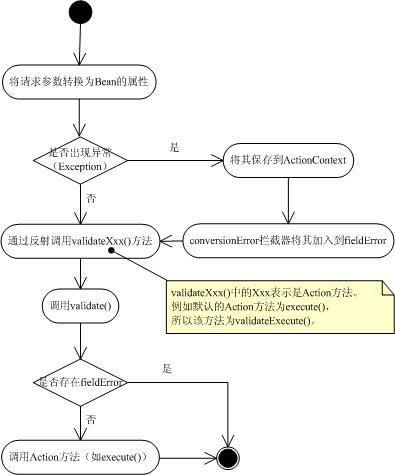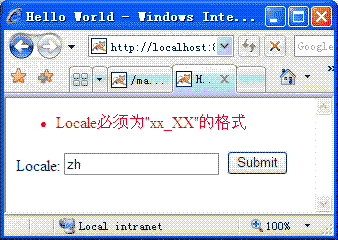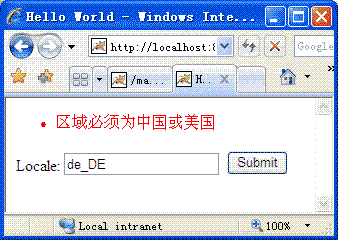- µĄÅĶ¦ł: 285258 µ¼Ī
- µĆ¦Õł½:

- µØźĶć¬: ń”ÅÕĘ×
-

µ¢ćń½ĀÕłåń▒╗
ńżŠÕī║ńēłÕØŚ
- µłæńÜäĶĄäĶ«» ( 2)
- µłæńÜäĶ«║ÕØø ( 252)
- µłæńÜäķŚ«ńŁö ( 570)
ÕŁśµĪŻÕłåń▒╗
- 2010-01 ( 1)
- 2009-11 ( 1)
- 2009-10 ( 1)
- µø┤ÕżÜÕŁśµĪŻ...
µ£Ćµ¢░Ķ»äĶ«║
-
1641606815’╝Ü
ÕÅ»õ╗źĶĆāĶÖæõĮ┐ńö©HttpClientÕ«×ńÄ░’╝īķéŻķāĮµś»Õ░üĶŻģÕźĮńÜäõĖ£Ķź┐’╝īõĮ┐ńö© ...
JavaÕåÖńÜäńł¼ĶÖ½ńÜäÕ¤║µ£¼ń©ŗÕ║Å -
SE_XiaoFeng’╝Ü
yajie ÕåÖķüōÕŬµ£ēÕ»╣httpÕŹÅĶ««µēŹĶĪī’╝īÕüćՔ鵣ēftpÕŹÅĶ««ÕæóŃĆéõĖŹ ...
JavaÕåÖńÜäńł¼ĶÖ½ńÜäÕ¤║µ£¼ń©ŗÕ║Å -
dongtianlaile’╝Ü
Õ”éµ×£µś»httpsńĮæń½Ö’╝īµĆÄõ╣łÕŖ×’╝¤
JavaÕåÖńÜäńł¼ĶÖ½ńÜäÕ¤║µ£¼ń©ŗÕ║Å -
yeelor’╝Ü
J2CMSµś»õĖĆõĖ¬Õ¤║õ║ÄJAVAEEÕ╣│ÕÅ░ńÜäĶĮ╗ķćŵ×üńÜäµĢŵŹĘÕ╝ĆÕÅæµ×ȵ×ä,Õ«× ...
javańÜäCMS’╝īÕēŹķĆöÕ£©Õō¬ķćī -
yeelor’╝Ü
j2cms
javańÜäCMS’╝īÕēŹķĆöÕ£©Õō¬ķćī
-Writing secure code
Õ£©ÕåÖÕēŹÕćĀń»ćµ¢ćń½ĀńÜ䵌ČÕĆÖ’╝īµ£ēõ║øµ£ŗÕÅŗÕ╗║Ķ««µłæńÜäÕåÖõĖĆń»ćÕģ│õ║ÄĶĪ©ÕŹĢµĢ░µŹ«µĀĪķ¬īńÜäµ¢ćń½ĀŃĆé µŁŻÕ”éµ¢ćń½ĀńÜäÕ╝ĆÕż┤µēĆÕ╝Ģńö©ńÜäŃĆŖWriting Secure CodeŃĆŗńÜäÕÉŹĶ©Ć’╝ÜŌĆ£µēƵ£ēńÜäĶŠōÕģźķāĮµś»ńĮ¬µüČńÜäŌĆØ’╝īµēĆõ╗źµłæõ╗¼Õ║öĶ»źÕ»╣µēƵ£ēńÜäÕż¢ķā©ĶŠōÕģźĶ┐øĶĪīµĀĪķ¬īŃĆéĶĆīĶĪ©ÕŹĢµś»Õ║öńö©ń©ŗÕ║ŵ£Ćń«ĆÕŹĢńÜäÕģźÕÅŻ’╝īÕ»╣ÕģČõ╝ĀĶ┐øµØźńÜäµĢ░µŹ«’╝īµłæõ╗¼Õ┐ģķĪ╗Ķ┐øĶĪīµĀĪ ķ¬īŃĆé
ĶĮ¼µŹóõĖĵĀĪķ¬ī’╝łConversion & Validation’╝ē
ÕģČÕ«×õĖŖń»ćµ¢ćń½Ā’╝īµłæµ£¼µØźµś»µēōń«ŚÕåÖĶĪ©ÕŹĢµĢ░µŹ«µĀĪķ¬īńÜäÕåģÕ«╣’╝īõĮåµś»ń╗ÅĶ┐ćÕåŹõĖēµĆØĶĆāÕÉÄ’╝īĶ┐śµś»Õå│Õ«ÜÕģłÕåÖStruts 2.0ĶĮ¼µŹóÕÖ©ńÜäÕåģÕ«╣ŃĆéÕĤÕøĀµś»µłæĶ«żõĖ║ĶĮ¼µŹóµś»µĀĪķ¬īńÜäÕ¤║ńĪĆ’╝īÕŬµ£ēÕ£©µĢ░µŹ«Ķó½µŁŻńĪ«Õ£░ĶĮ¼µŹóµłÉÕģČÕ»╣Õ║öńÜäń▒╗Õ×ŗÕÉÄ’╝īµłæõ╗¼µēŹÕÅ»õ╗źÕ»╣ÕģČÕÅ¢ÕĆ╝ĶīāÕø┤Ķ┐øĶĪīµĀĪķ¬īŃĆéń£ŗõĖ¬õŠŗÕŁÉńøĖõ┐ĪÕż¦Õ«ČÕÅ»õ╗źµø┤ µĖģµźÜŃĆéńÄ░Õ£©µłæõ╗¼Õ░▒µØźµö╣ķĆĀõĖĆõĖŗŃĆŖĶĮ¼µŹóÕÖ©’╝łConverter’╝ēŌĆöŌĆöStruts 2.0õĖŁńÜäķŁöµ£»ÕĖłŃĆŗńÜäń¼¼õĖĆõĖ¬õŠŗÕŁÉŃĆé
ķ”¢Õģł’╝īõ╗ÄActionÕ╝ĆÕ¦ŗ’╝īõ┐«µö╣ÕÉÄńÜäõ╗ŻńĀüÕ”éõĖŗ’╝Ü
 package tutorial;
package tutorial;
 import java.util.Locale;
import java.util.Locale;
 import com.opensymphony.xwork2.ActionSupport;
import com.opensymphony.xwork2.ActionSupport; import com.opensymphony.xwork2.util.LocalizedTextUtil;
import com.opensymphony.xwork2.util.LocalizedTextUtil;

 public class HelloWorld extends ActionSupport
public class HelloWorld extends ActionSupport  {
{ ┬Ā ┬Ā private String msg;
┬Ā ┬Ā private String msg; ┬Ā ┬Ā private Locale loc = Locale.US;
┬Ā ┬Ā private Locale loc = Locale.US; ┬Ā ┬Ā
┬Ā ┬Ā
 ┬Ā ┬Ā public String getMsg()
┬Ā ┬Ā public String getMsg()  {
{ ┬Ā ┬Ā ┬Ā ┬Ā return msg; ┬Ā ┬Ā ┬Ā ┬Ā
┬Ā ┬Ā ┬Ā ┬Ā return msg; ┬Ā ┬Ā ┬Ā ┬Ā ┬Ā ┬Ā}
┬Ā ┬Ā}  ┬Ā ┬Ā
┬Ā ┬Ā
 ┬Ā ┬Ā public Locale getLoc()
┬Ā ┬Ā public Locale getLoc()  {
{ ┬Ā ┬Ā ┬Ā ┬Ā return loc;
┬Ā ┬Ā ┬Ā ┬Ā return loc; ┬Ā ┬Ā}
┬Ā ┬Ā}  ┬Ā ┬Ā
┬Ā ┬Ā
 ┬Ā ┬Ā public void setLoc(Locale loc)
┬Ā ┬Ā public void setLoc(Locale loc)  {
{ ┬Ā ┬Ā ┬Ā ┬Ā this .loc = loc;
┬Ā ┬Ā ┬Ā ┬Ā this .loc = loc; ┬Ā ┬Ā}
┬Ā ┬Ā}  ┬Ā ┬Ā
┬Ā ┬Ā ┬Ā ┬Ā@Override
┬Ā ┬Ā@Override
 ┬Ā ┬Ā public void validate()
┬Ā ┬Ā public void validate()  {
{ ┬Ā ┬Ā ┬Ā ┬ĀSystem.out.println( " Calling validate()
┬Ā ┬Ā ┬Ā ┬ĀSystem.out.println( " Calling validate() " );
" );
 ┬Ā ┬Ā ┬Ā ┬Ā if ( ! (loc.equals(Locale.US) || loc.equals(Locale.CHINA)))
┬Ā ┬Ā ┬Ā ┬Ā if ( ! (loc.equals(Locale.US) || loc.equals(Locale.CHINA)))  {
{ ┬Ā ┬Ā ┬Ā ┬Ā ┬Ā ┬Ā ┬Ā ┬Ā ┬Ā ┬ĀaddFieldError( " loc " , getText( " validation.loc " ));
┬Ā ┬Ā ┬Ā ┬Ā ┬Ā ┬Ā ┬Ā ┬Ā ┬Ā ┬ĀaddFieldError( " loc " , getText( " validation.loc " )); ┬Ā ┬Ā ┬Ā ┬Ā}
┬Ā ┬Ā ┬Ā ┬Ā}  ┬Ā ┬Ā}
┬Ā ┬Ā}  ┬Ā ┬Ā ┬Ā ┬Ā
┬Ā ┬Ā ┬Ā ┬Ā
 ┬Ā ┬Ā public void validateExecute()
┬Ā ┬Ā public void validateExecute()  {
{ ┬Ā ┬Ā ┬Ā ┬ĀSystem.out.println( " Calling validateExecute() by reflection
┬Ā ┬Ā ┬Ā ┬ĀSystem.out.println( " Calling validateExecute() by reflection " );
" ); ┬Ā ┬Ā}
┬Ā ┬Ā}  ┬Ā ┬Ā
┬Ā ┬Ā ┬Ā ┬Ā@Override
┬Ā ┬Ā@Override
 ┬Ā ┬Ā public String execute()
┬Ā ┬Ā public String execute()  {
{ ┬Ā ┬Ā ┬Ā ┬ĀSystem.out.println( " Calling execute()
┬Ā ┬Ā ┬Ā ┬ĀSystem.out.println( " Calling execute() " );
" ); ┬Ā ┬Ā ┬Ā ┬Ā // LocalizedTextUtilµś»Struts 2.0õĖŁÕøĮķÖģÕī¢ńÜäÕĘźÕģĘń▒╗’╝ī<s:text>µĀćÕ┐ŚÕ░▒µś»ķĆÜĶ┐ćĶ░āńö©Õ«āÕ«×ńÄ░ÕøĮķÖģÕī¢ńÜä
┬Ā ┬Ā ┬Ā ┬Ā // LocalizedTextUtilµś»Struts 2.0õĖŁÕøĮķÖģÕī¢ńÜäÕĘźÕģĘń▒╗’╝ī<s:text>µĀćÕ┐ŚÕ░▒µś»ķĆÜĶ┐ćĶ░āńö©Õ«āÕ«×ńÄ░ÕøĮķÖģÕī¢ńÜä  ┬Ā┬Ā ┬Ā┬Ā ┬Ā ┬Ā ┬Āmsg = LocalizedTextUtil.findDefaultText( " HelloWorld " , loc);
┬Ā┬Ā ┬Ā┬Ā ┬Ā ┬Ā ┬Āmsg = LocalizedTextUtil.findDefaultText( " HelloWorld " , loc); ┬Ā ┬Ā ┬Ā ┬Ā return SUCCESS;
┬Ā ┬Ā ┬Ā ┬Ā return SUCCESS; ┬Ā ┬Ā}
┬Ā ┬Ā}  }
} ńäČÕÉÄ’╝īõ┐«µö╣Struts.xmlõĖŁActionńÜäÕ«Üõ╣ēµī浜ÄĶŠōÕģźÕ£░ÕØĆ’╝Ü
┬Ā ┬Ā < result > /HelloWorld.jsp </ result >
┬Ā ┬Ā < result name ="input" > /HelloWorld.jsp </ result >
</ action >
µÄźńØĆ’╝īÕ£©HelloWorld.jspõĖŁÕŖĀÕģźķöÖĶ»»µÅÉńż║’╝Ü
<% @taglib prefix = " s " uri = " /struts-tags " %>
< html >
< head >
┬Ā ┬Ā < title > Hello World </ title >
</ head >
< body >
┬Ā ┬Ā < div style ="color:red;" >
┬Ā ┬Ā ┬Ā ┬Ā < s:fielderror />
┬Ā ┬Ā </ div >
┬Ā ┬Ā < s:form action ="HelloWorld" theme ="simple" > ┬Ā ┬Ā ┬Ā ┬Ā ┬Ā ┬Ā
┬Ā ┬Ā ┬Ā ┬Ā Locale: < s:textfield name ="loc" /> < s:submit />
┬Ā ┬Ā </ s:form > ┬Ā ┬Ā
┬Ā ┬Ā < h2 >< s:property value ="msg" /></ h2 >
</ body >
</ html >
ÕåŹõ┐«µö╣LocaleConverter.javaµ¢ćõ╗Č’╝īÕ░åÕåģÕ«╣µö╣õĖ║’╝Ü
 package tutorial;
package tutorial;
 import java.util.Locale;
import java.util.Locale; import java.util.Map;
import java.util.Map; import java.util.regex.Pattern;
import java.util.regex.Pattern;

 public class LocaleConverter extends ognl.DefaultTypeConverter
public class LocaleConverter extends ognl.DefaultTypeConverter  {
{ ┬Ā ┬Ā@Override
┬Ā ┬Ā@Override
 ┬Ā ┬Ā public Object convertValue(Map context, Object value, Class toType)
┬Ā ┬Ā public Object convertValue(Map context, Object value, Class toType)  {
{
 ┬Ā ┬Ā ┬Ā ┬Ā if (toType == Locale. class )
┬Ā ┬Ā ┬Ā ┬Ā if (toType == Locale. class )  { ┬Ā ┬Ā ┬Ā ┬Ā ┬Ā ┬Ā
{ ┬Ā ┬Ā ┬Ā ┬Ā ┬Ā ┬Ā ┬Ā ┬Ā ┬Ā ┬Ā ┬Ā ┬ĀSystem.out.println( " Converting String to Locale
┬Ā ┬Ā ┬Ā ┬Ā ┬Ā ┬ĀSystem.out.println( " Converting String to Locale " );
" ); ┬Ā ┬Ā ┬Ā ┬Ā ┬Ā ┬ĀString locale = ((String[]) value)[ 0 ];
┬Ā ┬Ā ┬Ā ┬Ā ┬Ā ┬ĀString locale = ((String[]) value)[ 0 ]; ┬Ā ┬Ā ┬Ā ┬Ā ┬Ā ┬Ā return new Locale(locale.substring( 0 , 2 ), locale.substring( 3 ));
┬Ā ┬Ā ┬Ā ┬Ā ┬Ā ┬Ā return new Locale(locale.substring( 0 , 2 ), locale.substring( 3 ));
 ┬Ā ┬Ā ┬Ā ┬Ā} else if (toType == String. class )
┬Ā ┬Ā ┬Ā ┬Ā} else if (toType == String. class )  {
{ ┬Ā ┬Ā ┬Ā ┬Ā ┬Ā ┬ĀSystem.out.println( " Converting Locale to String
┬Ā ┬Ā ┬Ā ┬Ā ┬Ā ┬ĀSystem.out.println( " Converting Locale to String " );
" ); ┬Ā ┬Ā ┬Ā ┬Ā ┬Ā ┬ĀLocale locale = (Locale) value;
┬Ā ┬Ā ┬Ā ┬Ā ┬Ā ┬ĀLocale locale = (Locale) value; ┬Ā ┬Ā ┬Ā ┬Ā ┬Ā ┬Ā return locale.toString();
┬Ā ┬Ā ┬Ā ┬Ā ┬Ā ┬Ā return locale.toString(); ┬Ā ┬Ā ┬Ā ┬Ā}
┬Ā ┬Ā ┬Ā ┬Ā}  ┬Ā ┬Ā ┬Ā ┬Ā return null ;
┬Ā ┬Ā ┬Ā ┬Ā return null ; ┬Ā ┬Ā}
┬Ā ┬Ā}  }
} õ╣ŗÕÉÄ’╝īõ┐«µö╣ÕøĮķÖģÕī¢ĶĄäµ║ɵ¢ćõ╗Č’╝īÕåģÕ«╣õĖ║’╝Ü
invalid.fieldvalue.loc = LocaleÕ┐ģķĪ╗õĖ║\ " xx_XX\ " ńÜäµĀ╝Õ╝Å
validation.loc = Õī║Õ¤¤Õ┐ģķĪ╗õĖ║õĖŁÕøĮµł¢ńŠÄÕøĮ
invalid.fieldvalue.loc = Locale must like \ " xx_XX\ "
validation.loc = Locale must be China or USA
ÕÅæÕĖāĶ┐ÉĶĪīÕ║öńö©ń©ŗÕ║Å’╝īÕ£©µĄÅĶ¦łÕÖ©õĖŁķö«Õģźhttp://localhost:8080/Struts2_Validation/HelloWorld.action’╝īÕ£©LocaleõĖŁĶŠōÕģźzh_CN’╝īµīēŌĆ£SubmitŌĆصÅÉõ║ż’╝īµĢłµ×£Õ”éõĖŖń»ćµ¢ćń½ĀµēĆńż║ŃĆéĶĆīÕ£©µ£ŹÕŖĪÕÖ©µÄ¦ÕłČÕÅ░µ£ēÕ”éõĖŗĶŠōÕć║’╝Ü
Calling validateExecute() by reflection...
Calling validate()...
Calling execute()...
Converting Locale to String...
õĖŖĶ┐░ńÜäĶŠōÕć║Ķ»┤µśÄõ║åStruts 2.0ńÜäµĢ░µŹ«µĀĪķ¬īÕĘźõĮ£µ¢╣Õ╝Å’╝īÕ«āķ£ĆĶ”üń╗ÅĶ┐ćõĖŗķØóÕćĀõĖ¬µŁźķ¬ż’╝Ü
- ķĆÜĶ┐ćĶĮ¼µŹóÕÖ©Õ░åĶ»Ęµ▒éÕÅéµĢ░ĶĮ¼µŹóµłÉńøĖÕ║öńÜäBeanÕ▒׵Ʀ’╝ø
- Õłżµ¢ŁĶĮ¼µŹóĶ┐ćń©ŗµś»ÕÉ”Õć║ńÄ░Õ╝éÕĖĖŃĆéÕ”éµ×£µ£ē’╝īÕłÖÕ░åÕģČõ┐ØÕŁśÕł░ActionContextõĖŁ’╝īconversionErrorµŗ”µł¬ÕÖ©ÕåŹÕ░üĶŻģõĖ║fieldError’╝øÕ”éµ×£µ▓Īµ£ē’╝īĶ┐øĶĪīõĖŗõĖƵŁź’╝ø
- ķĆÜĶ┐ćÕÅŹÕ░ä’╝łReflection’╝ēµØźĶ░āńö©validateXxx()µ¢╣µ│Ģ’╝łÕģČõĖŁ’╝īXxxĶĪ©ńż║ActionńÜäµ¢╣µ│ĢÕÉŹ’╝ē’╝ø
- Ķ░āńö©validate()µ¢╣µ│Ģ’╝ø
- Õ”éµ×£ń╗ÅĶ┐ćõĖŖĶ┐░µŁźķ¬żµ▓Īµ£ēÕć║ńÄ░fieldError’╝īÕłÖĶ░āńö©Actionµ¢╣µ│Ģ’╝øÕ”éµ×£µ£ē’╝īÕłÖõ╝ÜĶĘ│Ķ┐ćActionµ¢╣µ│Ģ’╝īķĆÜĶ┐ćÕøĮķÖģÕī¢Õ░åfieldErrorĶŠōÕć║Õł░ķĪĄķØóŃĆé
õĖŹÕ¢£µ¼óń£ŗµ¢ćÕŁŚńÜäµ£ŗÕÅŗ’╝īÕÅ»õ╗źÕÅéĶĆāõĖŗķØóńÜäÕøŠ1ŃĆé

ÕøŠ1 µĀĪķ¬īķĪ║Õ║ÅÕøŠ
ń£ŗÕł░Ķ┐ÖķćīÕÅ»ĶāĮÕż¦Õ«Čõ╝Üń¢æķŚ«’╝ÜŌĆ£Ķ┐Öõ╣łÕżÜÕ£░µ¢╣ÕÅ»õ╗źµĀĪķ¬īĶĪ©ÕŹĢµĢ░µŹ«’╝īÕł░Õ║ĢµłæÕ║öĶ»źÕ£©ķéŻķćīÕüÜÕæó’╝¤ŌĆص£ēķĆēµŗ®µś»ÕźĮõ║ŗ’╝īõĮåµŖēµŗ®ńÜäĶ┐ćń©ŗÕŠĆÕŠĆµś»ńŚøĶŗ”ńÜä’╝īÕŠĆÕŠĆĶ«®õ║║õĖŹń¤źµēƵĬŃĆéÕ”éµ×£Õż¦Õ«ČÕÅéńģ¦õ╗źõĖŗÕćĀńé╣Õ╗║Ķ««’╝īńøĖõ┐Īõ╝ܵ»öĶŠāÕ«╣µśōÕ£░ÕüÜÕć║µŁŻńĪ«ńÜäµŖēµŗ®ŃĆé
- Õ”é µ×£ķ£ĆĶ”üĶĮ¼µŹóńÜäµĢ░µŹ«’╝īķĆÜÕĖĖÕüܵ│ĢÕ£©ĶĮ¼µŹóńÜ䵌ČÕĆÖÕüܵĀ╝Õ╝ÅńÜäµĀĪķ¬ī’╝īÕ£©ActionõĖŁńÜäµĀĪķ¬īµ¢╣µ│ĢõĖŁµĀĪķ¬īÕÅ¢ÕĆ╝ŃĆéÕüćÕ”éńö©µłĘÕĪ½ķöÖõ║åµĀ╝Õ╝Å’╝īµłæõ╗¼ÕÅ»õ╗źķĆÜĶ┐ćÕ£©ĶĄäµ║ɵ¢ćõ╗ČķģŹńĮ« invalid.fieldvalue.xxx’╝łxxxõĖ║Õ▒׵ƦÕÉŹ’╝ēµØźµÅÉńż║ńö©µłĘµŁŻńĪ«ńÜäµĀ╝Õ╝Å’╝īõĖŹÕÉīńÜäķśČµ«ĄÕć║ķöÖµśŠńż║õĖŹÕÉīńÜäõ┐Īµü»ŃĆéÕģĘõĮōÕüܵ│ĢĶ»ĘÕÅéĶĆāõĖŖķØóńÜäõŠŗÕŁÉ’╝ø
- Ķć│õ║Äńö©validate()Ķ┐śµś»validateXxx()’╝īµłæµÄ©ĶŹÉõĮ┐ńö©validate()ŃĆéÕĤÕøĀµś»validateXxx()õĮ┐ńö©õ║åÕÅŹÕ░ä’╝īńøĖÕ»╣µØźĶ»┤µĆ¦ĶāĮń©ŹÕĘ«’╝īĶĆīvalidate()ÕłÖµś»ķĆÜĶ┐ćµÄźÕÅŻcom.opensymphony.xwork2.ValidateableĶ░āńö©ŃĆéÕĮōńäČÕ”éµ×£õĮĀńÜäĶĪ©ÕŹĢµĢ░µŹ«ÕÅ¢ÕĆ╝µś»ÕÅ¢Õå│õ║Äńē╣Õ«ÜActionµ¢╣µ│Ģ’╝īÕłÖÕ║öĶ»źõĮ┐ńö©validateXxx()ŃĆé
Õ£©Ķ┐ÉĶĪīõĖŖķØóńÜäõŠŗÕŁÉµŚČ’╝īÕ£©LocaleõĖŁĶŠōÕģźzhÕ╣ȵÅÉõ║żµŚČÕć║ńÄ░ÕøŠ2µēĆńż║ķĪĄķØóŃĆé

ÕøŠ2 ķöÖĶ»»µĀ╝Õ╝Å
Õ£©LocaleõĖŁĶŠōÕģźde_DEµŚČ’╝īÕć║ńÄ░Õ”éÕøŠ3µēĆńż║ķĪĄķØóŃĆé

ÕøŠ3 ÕÅ¢ÕĆ╝ķöÖĶ»»
õĮ┐ńö©Struts 2.0ńÜäµĀĪķ¬īµĪåµ×Č
õĖŖõĖĆĶŖéńÜäÕåģÕ«╣ķāĮµś»Õģ│õ║ÄÕ”éõĮĢń╝¢ń©ŗÕ«×ńÄ░µĀĪķ¬ī’╝īĶ┐Öķā©ÕłåÕĘźõĮ£Õż¦ķāĮµś»ÕŹĢĶ░āńÜäķćŹÕżŹŃĆéµø┤ÕżÜµāģÕåĄõĖŗ’╝īµłæõ╗¼õĮ┐ńö©Struts 2.0ńÜäµĀĪķ¬īµĪåµ×Č’╝īķĆÜĶ┐ćķģŹńĮ«Õ«×ńÄ░õĖĆõ║øÕĖĖĶ¦üńÜäµĀĪķ¬īŃĆé
µłæÕŁ”õ╣Āń╝¢ń©ŗµ£ēõĖ¬õ╣Āµā»ŌĆöŌĆöÕ¢£µ¼óÕģłń£ŗĶŠōÕć║ń╗ōµ×£’╝īÕåŹń£ŗõ╗ŻńĀüÕ«×ńÄ░ŃĆéĶ┐ÖµĀĘÕŁ”ńÜäÕźĮÕżäµś»Õģłń£ŗń╗ōµ×£ÕÅ»õ╗źÕł║µ┐ĆÕŁ”õ╣ĀńÜäµ┐Ƶāģ’╝īõ╣¤ÕÅ»õ╗źÕ£©ń£ŗõ╗ŻńĀüÕēŹĶć¬ÕĘ▓µĆØĶĆāõĖĆõĖŗÕ”éõĮĢÕ«×ńÄ░’╝īńäČÕÉÄÕĖ”ńØĆķŚ«ķóśÕÄ╗ń£ŗõ╗ŻńĀü’╝īķéŻÕ░▒µĖģµÖ░ÕżÜõ║åŃĆéÕøĀµŁżõĖŗķØóµłæõ╗¼ÕģłµØźÕüܵ╝öńż║ŃĆé
ķ”¢Õģł’╝īÕ£©tutorialÕīģõĖŗµ¢░Õ╗║ValidationAction.java’╝īõ╗ŻńĀüÕ”éõĖŗ’╝Ü
 package tutorial;
package tutorial;
 import com.opensymphony.xwork2.ActionSupport;
import com.opensymphony.xwork2.ActionSupport;

 public class ValidationAction extends ActionSupport
public class ValidationAction extends ActionSupport  {
{ ┬Ā ┬Ā private String reqiuredString;
┬Ā ┬Ā private String reqiuredString;

 ┬Ā ┬Ā public String getReqiuredString()
┬Ā ┬Ā public String getReqiuredString()  {
{ ┬Ā ┬Ā ┬Ā ┬Ā return reqiuredString;
┬Ā ┬Ā ┬Ā ┬Ā return reqiuredString; ┬Ā ┬Ā}
┬Ā ┬Ā} 

 ┬Ā ┬Ā public void setReqiuredString(String reqiuredString)
┬Ā ┬Ā public void setReqiuredString(String reqiuredString)  {
{ ┬Ā ┬Ā ┬Ā ┬Ā this .reqiuredString = reqiuredString;
┬Ā ┬Ā ┬Ā ┬Ā this .reqiuredString = reqiuredString; ┬Ā ┬Ā}
┬Ā ┬Ā}  ┬Ā ┬Ā
┬Ā ┬Ā ┬Ā ┬Ā@Override
┬Ā ┬Ā@Override
 ┬Ā ┬Ā public String execute()
┬Ā ┬Ā public String execute()  {
{ ┬Ā ┬Ā ┬Ā ┬Ā return SUCCESS;
┬Ā ┬Ā ┬Ā ┬Ā return SUCCESS; ┬Ā ┬Ā} ┬Ā ┬Ā
┬Ā ┬Ā} ┬Ā ┬Ā }
} ńäČÕÉÄ’╝īķģŹńĮ«õĖŖĶ┐░µēĆÕ╗║ńÜäAtion’╝īõ╗ŻńĀüńē浫ĄÕ”éõĖŗ’╝Ü
┬Ā ┬Ā < result > /Output.jsp </ result >
┬Ā ┬Ā < result name ="input" > /Input.jsp </ result >
</ action >
µÄźńØĆ’╝īÕłøÕ╗║Input.jspÕÆīOutput.jsp’╝īÕåģÕ«╣ÕłåÕł½Õ”éõĖŗ’╝Ü
<% @taglib prefix = " s " uri = " /struts-tags " %>
< html
- 2007-05-03 21:56
- µĄÅĶ¦ł 2066
- Ķ»äĶ«║(0)
- Ķ«║ÕØøÕø×ÕżŹ / µĄÅĶ¦ł (0 / 1991)
- Õłåń▒╗:õ╝üõĖܵ×ȵ×ä
- µ¤źń£ŗµø┤ÕżÜ
ÕÅæĶĪ©Ķ»äĶ«║
-
ĶĽÕÉŹÕģČÕ”ÖńÜäĶ¦ŻÕå│õ║åStruts2ńÜäõĖĆõĖ¬ķŚ«ķóś
2007-05-04 14:38 17483Ķ┐Ö2Õż®Õ╝ĆÕ¦ŗÕŁ”õ╣ĀStruts2’╝īµł ... -
Õ£©Struts 2õĖŁÕ«×ńÄ░IoC
2007-05-03 21:57 1697IoC(Inversion of Control ... -
Struts 2ńÜäÕ¤║ń¤│ŌĆöŌĆöµŗ”µł¬ÕÖ©’╝łInterceptor’╝ē
2007-05-03 21:57 2191ķ”¢Õģł’╝īĶ”üĶĘ¤Õż¦Õ ... -
ĶĮ¼µŹóÕÖ©’╝łConverter’╝ēŌĆöŌĆöStruts 2.0õĖŁńÜäķŁöµ£»ÕĖł
2007-05-03 21:55 2796Õ£©µłæÕĘ▓ÕŠĆńÜäStruts 1.x ... -
Õ£©Struts 2.0õĖŁÕøĮķÖģÕī¢(i18n)µé©ńÜäÕ║öńö©ń©ŗÕ║Å
2007-05-03 21:54 2084ÕøĮķÖģÕī¢µś»ÕĢåõĖÜń│╗ń╗¤õĖŁõĖŹÕÅ»µł¢ń╝║ńÜäõĖĆķā©Õłå’╝īµēĆõ╗źµŚĀĶ«║µé©ÕŁ” ... -
Struts 2.0ńÜäActionĶ«▓Ķ¦Ż
2007-05-03 21:52 1792µ£ēStruts 1.xń╗Åķ¬īńÜäµ£ŗÕÅŗķāĮń¤źķüōActio ... -
ÕĖĖńö©ńÜäStruts 2.0ńÜäµĀćÕ┐Ś’╝łTag’╝ēõ╗ŗń╗Ź
2007-05-03 21:51 1960Õ£©õĖŖõĖĆń»ćµ¢ćń½ĀŃĆŖõĖ║Struts ... -
õĖ║Struts 2.0ÕüÜÕźĮÕćåÕżć
2007-05-03 21:50 3165StrutsõĮ£õĖ║MVC 2ńÜäWebµĪåµ×Č’╝īĶ欵ĩÕć║õ╗ź ...






ńøĖÕģ│µÄ©ĶŹÉ
06 Õ£©Struts 2.0õĖŁÕ«×ńÄ░ĶĪ©ÕŹĢµĢ░µŹ«µĀĪķ¬ī’╝łValidation’╝ē 07 Struts 2ńÜäÕ¤║ń¤│ŌĆöŌĆöµŗ”µł¬ÕÖ©’╝łInterceptor’╝ē 08 Õ£©Struts 2õĖŁÕ«×ńÄ░IoC 09 Õ£©Struts 2õĖŁÕ«×ńÄ░µ¢ćõ╗ČõĖŖõ╝Ā 10 Õ£©Struts 2õĖŁÕ«×ńÄ░CRUD 11 Struts 2õĖŁńÜäOGNL 12 trus 2ńÜäµ¢░...
Õ£©Struts 2.0õĖŁÕ«×ńÄ░ĶĪ©ÕŹĢµĢ░µŹ«µĀĪķ¬ī’╝łValidation’╝ē Struts 2ńÜäÕ¤║ń¤│ŌĆöŌĆöµŗ”µł¬ÕÖ©’╝łInterceptor’╝ē Õ£©Struts 2õĖŁÕ«×ńÄ░IoC Õ£©Struts 2õĖŁÕ«×ńÄ░µ¢ćõ╗ČõĖŖõ╝Ā Õ£©Struts 2õĖŁÕ«×ńÄ░CRUD Struts 2õĖŁńÜäOGNL Strus 2ńÜäµ¢░ĶĪ©ÕŹĢµĀćÕ┐ŚńÜäõĮ┐ńö© ...
06 Õ£©Struts 2.0õĖŁÕ«×ńÄ░ĶĪ©ÕŹĢµĢ░µŹ«µĀĪķ¬ī’╝łValidation’╝ē 07 Struts 2ńÜäÕ¤║ń¤│ŌĆöŌĆöµŗ”µł¬ÕÖ©’╝łInterceptor’╝ē 08 Õ£©Struts 2õĖŁÕ«×ńÄ░IoC 09 Õ£©Struts 2õĖŁÕ«×ńÄ░µ¢ćõ╗ČõĖŖõ╝Ā 10 Õ£©Struts 2õĖŁÕ«×ńÄ░CRUD 11 Struts 2õĖŁńÜäOGNL 12 trus 2ńÜäµ¢░...
06 Õ£©Struts 2.0õĖŁÕ«×ńÄ░ĶĪ©ÕŹĢµĢ░µŹ«µĀĪķ¬ī’╝łValidation’╝ē 07 Struts 2ńÜäÕ¤║ń¤│ŌĆöŌĆöµŗ”µł¬ÕÖ©’╝łInterceptor’╝ē 08 Õ£©Struts 2õĖŁÕ«×ńÄ░IoC 09 Õ£©Struts 2õĖŁÕ«×ńÄ░µ¢ćõ╗ČõĖŖõ╝Ā 10 Õ£©Struts 2õĖŁÕ«×ńÄ░CRUD 11 Struts 2õĖŁńÜäOGNL 12 Struts 2ńÜä...
1.õĖ║Struts 2.0ÕüÜÕźĮÕćåÕżć 2.ÕĖĖńö©ńÜäStruts 2.0ńÜäµĀćÕ┐Ś’╝łTag’╝ēõ╗ŗń╗Ź 3.Struts 2.0ńÜäActionĶ«▓Ķ¦Ż ...5.ĶĮ¼µŹóÕÖ©’╝łConverter’╝ēŌĆöŌĆöStruts 2.0õĖŁńÜäķŁöµ£»ÕĖł Õ£©6.Struts 2.0õĖŁÕ«×ńÄ░ĶĪ©ÕŹĢµĢ░µŹ«µĀĪķ¬ī’╝łValidation’╝ē 7....... 8.......
┬ĘStruts 2.0õĖŁÕ«×ńÄ░ĶĪ©ÕŹĢµĢ░µŹ«µĀĪķ¬ī’╝łValidation’╝ē ┬ʵŗ”µł¬ÕÖ©’╝łInterceptor’╝ē ┬ĘStruts 2õĖŁÕ«×ńÄ░IoC ┬ĘStruts 2õĖŁÕ«×ńÄ░µ¢ćõ╗ČõĖŖõ╝Ā ┬ĘStruts 2õĖŁńÜäOGNL ┬ĘStrus 2ńÜäµ¢░ĶĪ©ÕŹĢµĀćńŁŠńÜäõĮ┐ńö© ┬ĘStruts 2õĖÄAJAX ┬ĘStruts2ÕłåķĪĄ ...
Struts 2ńÜäÕ¤║ń¤│ŌĆöŌĆöµŗ”µł¬ÕÖ©’╝łInterceptor);Õ£©Struts 2_0õĖŁÕøĮķÖģÕī¢(i18n)µé©ńÜäÕ║öńö©ń©ŗÕ║Å;Õ£©Struts 2_0õĖŁÕ«×ńÄ░ĶĪ©ÕŹĢµĢ░µŹ«µĀĪķ¬ī’╝łValidation’╝ē;Struts 2õĖÄAJAX;Õ£©Struts 2õĖŁÕ«×ńÄ░IoC......
µĢ░µŹ«Õ║ōÕīģµŗ¼ńö©µłĘĶĪ©ÕÆīµ¢ćõ╗ČĶĪ©’╝īķĪ╣ńø«õĖ╗õĮōńö▒Struts2µĪåµ×ȵɣÕ╗║’╝īÕēŹÕÅ░jspķĪĄķØóĶĪ©ÕŹĢõĮ┐ńö©OGNLµĀćńŁŠ’╝īXX_zh_CN(en_US).propertiesµ¢ćõ╗ČÕ«×ńÄ░õĖŁĶŗ▒µ¢ćÕøĮķÖģÕī¢’╝īXXAction-validation.xmlÕ«×ńÄ░ĶĪ©ÕŹĢµĀĪķ¬ī’╝īMD5ÕŖĀջ嵢ćõ╗Čń╗ØÕ»╣ĶĘ»ÕŠä’╝īõ┐صŖżµ¢ćõ╗ČÕ«ēÕģ©...
õĮ┐ńö©struts2ķ¬īĶ»üµĪåµ×ČÕ«×ńÄ░ĶĪ©ÕŹĢķ¬īĶ»ü’╝īõ╣¤ÕÅ»õ╗źńø┤µÄźõĮ┐ńö©validation’╝ł’╝ē
ĶĪ©ÕŹĢµĀĪķ¬ī: avlidationÕīģ: LocaleConverter.java Locales.java ValidationHWorld.java globalMessage_en_US.properties globalMessage_zh_CN.properties struts.properties xwork-conversion.propertie ...
130ŃĆüÕ”éõĮĢķś▓µŁóÕ£©JSPµł¢SERVLETõĖŁńÜäĶŠōÕć║õĖŹĶó½BROWSERõ┐ØÕŁśÕ£©CACHEõĖŁ? 32 131ŃĆüÕ£©JSPõĖŁÕ”éõĮĢĶ«ŠńĮ«COOKIE? 32 132ŃĆüÕ£©JSPõĖŁÕ”éõĮĢÕłĀķÖżõĖĆõĖ¬COOKIE? 32 133ŃĆüÕ£©õĖĆõĖ¬JSPńÜäĶ»Ęµ▒éÕżäńÉåõĖŁÕ”éõĮĢÕü£µŁóJSPńÜäµē¦ĶĪī 33 134ŃĆüÕ£©JSPõĖŁÕ”éõĮĢÕ«Üõ╣ē...
130ŃĆüÕ”éõĮĢķś▓µŁóÕ£©JSPµł¢SERVLETõĖŁńÜäĶŠōÕć║õĖŹĶó½BROWSERõ┐ØÕŁśÕ£©CACHEõĖŁ? 32 131ŃĆüÕ£©JSPõĖŁÕ”éõĮĢĶ«ŠńĮ«COOKIE? 32 132ŃĆüÕ£©JSPõĖŁÕ”éõĮĢÕłĀķÖżõĖĆõĖ¬COOKIE? 32 133ŃĆüÕ£©õĖĆõĖ¬JSPńÜäĶ»Ęµ▒éÕżäńÉåõĖŁÕ”éõĮĢÕü£µŁóJSPńÜäµē¦ĶĪī 33 134ŃĆüÕ£©JSPõĖŁÕ”éõĮĢÕ«Üõ╣ē...
2.4.4. StrutsÕ”éõĮĢÕ«×ńÄ░ Model 2, MVC, ÕÆīÕłåÕ▒é............................................................49 2.5. Struts µÄ¦ÕłČµĄü...............................................................................
2.4.4. Struts Õ”éõĮĢÕ«×ńÄ░Model 2, MVC, ÕÆīÕłåÕ▒é............................................................49 2.5. Struts µÄ¦ÕłČµĄü................................................................................